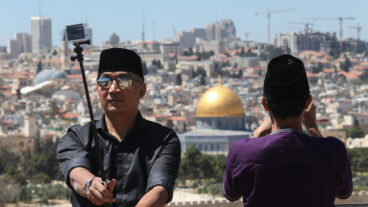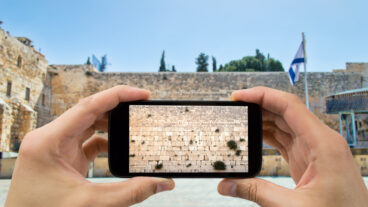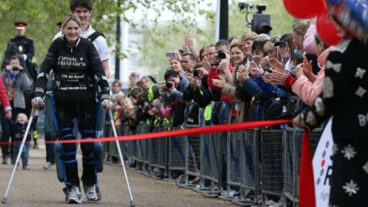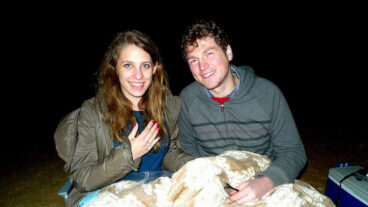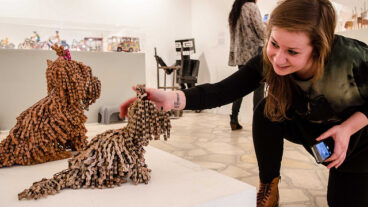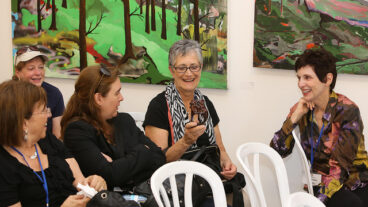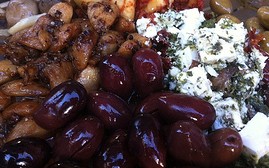In this corner of the world, the environment does not know political boundaries.There are a number of explanations why the Dead Sea, the lowest point on earth, is so named. One answer: because unlike other seas, she does not have an outlet for her water. The Jordan River feeds her, but she does not share her water. One who does not share is as good as dead.
My early morning bus had just passed the Dead Sea and made the turn to begin the climb through the Judean desert towards Jerusalem. Near Jericho an elderly Palestinian man entered the bus. Immediately an Israeli soldier stood and gave him his seat. It was a small gesture with its own larger implications. At this time of year the usually barren brown hills outside of Jerusalem are covered with a light carpet of green from the winter rains – a symbol of rebirth during the dark days of winter.
I was traveling to Jerusalem to meet a friend, one of the Palestinian alumni of our Arava Institute for Environmental Studies program. I was to meet him near the Damascus Gate in Arab East Jerusalem, from where we would continue into Abu Dis to meet two Palestinians interested in studying with our program.
Since 1996 the Arava Institute has successfully brought undergraduate and graduate Israeli Jews and Arabs, Palestinians, Jordanians, Egyptians, and Tunisians, as well as Americans and others from around the world to live together and study the environment on Kibbutz Ketura. In the United States I was in charge of North American student recruitment; here I had moved to Palestinian student recruitment. Since my return to Ketura in the summer I had slowly learned the nuance of that work, made more complicated by the second Intifada.
Outside the Jerusalem Central Bus Station I hailed a taxi and asked the driver to take me to the Damascus Gate. He asked me what my business was there, surprised and perhaps even suspicious why a Jew would want to go there. We took the main road that leads to the Damascus Gate, following what had been the border between Israel and Jordan from 1948 to 1967, when Jerusalem had been a divided city.
Despite the unification of Jerusalem in the Six Day War, and particularly since the first Intifada 17 years ago, this holy city has remained psychologically divided. There are no walls that separate Jewish West Jerusalem from Arab East Jerusalem, but most people act as though one exists; to cross from one section to another is to cross to the ‘other’ side.
Along the way we passed where the Mandelbaum Gate once stood. Operated by the U.N. from in 1948 to 1967, this was the only place to cross from West to East Jerusalem during those years. I had first seen it in 1966 when I was eight years old. Then, as I watched the UN cars go through the gate, I could not understand why we were not allowed as Jews to cross over and see the Jewish holy sites there. Now, I would see in Abu Dis the separation wall that Israel was building to keep Palestinians out of Jerusalem.
The wall’s path prevented us from driving directly to Abu Dis from Jerusalem. We took a taxi from the Damascus Gate to the entrance of Ma’ale Adumim on the outskirts of Jerusalem, where another of the Arava Institute’s Palestinian alumni picked us up in her car and drove us into Abu Dis. The streets of Abu Dis are narrow, filled with many potholes, and run down. To say I was not a bit apprehensive would not be true.
While I felt very comfortable going to East Jerusalem, as I had with my wife and children the previous week, going to Abu Dis was of a different magnitude. However, once we arrived at a restaurant for our meeting I felt at ease. I completely trusted my two friends who accompanied me; once there, the fear of the unknown disappeared in the smiles that met me, the pizza we ate.
The meeting was unremarkable in how common we appeared: four people sitting at a table in a restaurant sharing a meal. The pizza was vegetarian so I could follow the laws of kashrut. I also wore a yarmulke – in my case not the traditional flat, circular variety but a more generic Middle Eastern head covering that allowed me to blend into both Jewish and Arab communities. I wear the same yarmulke in New York City where individuals pass me saying ‘Shalom Alechem‘ or ‘Salum Alekum,‘ depending who they are.
The two potential students both came from the Hebron area and spoke about their desires to advance their education in the environmental field. While the primary focus of the Arava Institute is environmental studies, we have discovered that the environment is able to act as the metaphor, the level playing field, and the glue that allows our students to meet each other as equals and confront, without things falling apart, the difficult political issues that cannot be avoided with such a constellation of students.
I asked them what they thought would be the reaction of their family and friends to their participation in a program where they would study and live with the other side? Both responded that they did not think that it would be a problem. We know from previous experiences that that is not always the case; that cultural and political pressures are not always so benevolent. As one of them put it, he wanted to learn more so that he could help the Palestinian people. He understood, particularly in this little corner of the world, that the environment does not know from political boundaries. When it comes to the environment cooperation, not unilateralism, is the only option for environmental improvement and care.
We are reminded, at this time of year, by Hannukah, Christmas, and Kwanzaa of the power and importance of bringing light where there is darkness. There are scores of organizations here like the Arava Institute doing their work in conflict mitigation. Most of the work goes unreported, falling into the category of soft news, though it creates hard facts and tangible results. They are the small gestures with large consequences.
While there is a natural ebb and flow of diplomacy, those programs provide a constant working model on the ground for a peaceful vision of the Middle East so many of us hope for. In recent weeks a more peaceful tide has begun to wash ashore. The many programs like ours provide a beacon of light, showing that the reconciliation of the children of Abraham is, in the words of Eric Severeid, ‘not so wild a dream.’




